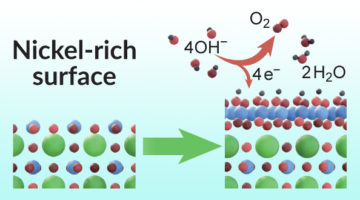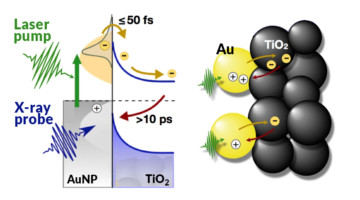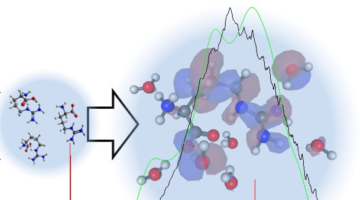Sulfur isotope patterns in ancient rock layers inform our understanding of Earth’s Archean atmosphere. Before the Great Oxygenation Event (~2.4 billion years ago), hard ultraviolet light penetrated into the Earth’s surface, photodissociating sulfur dioxide directly to S + O2. This new product channel may help resolve discrepancies in the Earth’s evolutionary history. Read more »
Tuning of One Atomic Layer Unlocks Catalytic Pathway
An atomically precise surface probe helped researchers discover that a catalyst can be activated by tuning the composition of just one atomic surface layer. The work sharpens our understanding of how surface changes can improve the production of hydrogen fuel from water using efficient catalysts made of inexpensive materials. Read more »![]()
![]()
Scientists Capture Candid Snapshots of Electrons Harvesting Light at the Atomic Scale
A team of scientists has gained important new insight into electrons’ role in the harvesting of light in gold/TiO2 nanoparticle photoelectrochemical (PEC) systems. The scientists say that their study can help researchers develop more efficient material combinations for the design of high-performance solar fuels devices. Read more »
A Probe of Light-Harvesting Efficiency at the Nanoscale
Using time-resolved experiments at the ALS, researchers found a way to count electrons moving back and forth across a model interface for photoelectrochemical cells. The findings provide real-time, nanoscale insight into the efficiency of nanomaterial catalysts that help turn sunlight and water into fuel through artificial photosynthesis. Read more »![]()
![]()
The Beauty of Imperfections: Linking Atomic Defects to 2D Materials’ Electronic Properties
Two studies reveal surprising details on how some atomic defects emerge in transition metal dichalcogenides (TMDs), and how those defects shape the material’s electronic properties. The findings could provide a more platform for designing 2D materials for quantum information science and smaller, more powerful optoelectronics. Read more »
Fundamental Property of Arginine Revealed Through Solvation
Just 20 amino acids act as building blocks for all our proteins, but their chemical properties have been difficult to study at the most fundamental level. Combining experiments and theory at the ALS, researchers have now determined the ionization energy of arginine, an amino acid with over 100 isomers. Read more »
Berkeley Lab and SLAC Host Hard X-Ray Photoemission Conference
Earlier this month, Berkeley Lab and SLAC hosted the 7th International Conference on Hard X-Ray Photoelectron Spectroscopy (HAXPES). This biennial meeting has grown from a small workshop held at ESRF in 2003 with about 50 participants, to a truly international event, which this year attracted 150 participants from 20 countries. Read more »






